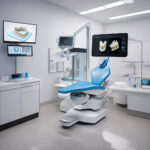Researchers Unveil World’s First Soft Probe for Non-Destructive Micro-LED Testing
In the realm of micro-LED technology, a groundbreaking innovation has emerged, promising to revolutionize the way we test and inspect these tiny yet powerful components. Scientists have introduced the world’s first soft probe designed specifically for non-destructive micro-LED testing, marking a significant leap forward in the field of semiconductor research.
It took scientists just 0.9 megapascals of pressure to pierce a problem holding back the advancement of micro-LED technology. Traditional methods of testing micro-LEDs often involve rigid probes that can inadvertently damage or alter the delicate structures of these tiny devices. The introduction of the soft probe not only mitigates the risk of damage but also allows for more accurate and reliable testing procedures, ultimately leading to enhanced performance and longevity of micro-LED products.
This innovative soft probe is the result of extensive research and development efforts aimed at addressing the challenges associated with testing micro-LEDs. By employing a gentle yet effective approach, researchers have successfully overcome the limitations of existing testing methods, paving the way for new possibilities in the field of semiconductor technology.
One of the key advantages of the soft probe is its ability to provide non-destructive testing of micro-LEDs, allowing researchers to assess the performance and quality of these devices without causing any harm. This non-invasive testing method not only ensures the integrity of the micro-LEDs but also streamlines the testing process, saving time and resources for manufacturers and researchers alike.
Furthermore, the soft probe offers enhanced flexibility and precision, enabling researchers to conduct detailed analyses of micro-LEDs with unprecedented accuracy. By gently interacting with the surface of the devices, the soft probe can gather valuable data and insights that were previously inaccessible, opening up new possibilities for optimizing the performance and efficiency of micro-LED technology.
The introduction of the soft probe represents a significant milestone in the evolution of micro-LED technology, showcasing the power of innovation and collaboration in driving progress in the field of semiconductor research. As researchers continue to push the boundaries of what is possible, we can expect to see further advancements that will shape the future of micro-LED technology and its applications across various industries.
In conclusion, the world’s first soft probe for non-destructive micro-LED testing holds immense potential for transforming the way we approach semiconductor research and development. By overcoming the limitations of traditional testing methods and offering a more gentle and precise alternative, this innovative technology is set to accelerate the pace of innovation in the field of micro-LEDs, ushering in a new era of possibilities for this cutting-edge technology.
innovation, micro-LED, soft probe, semiconductor, technology












